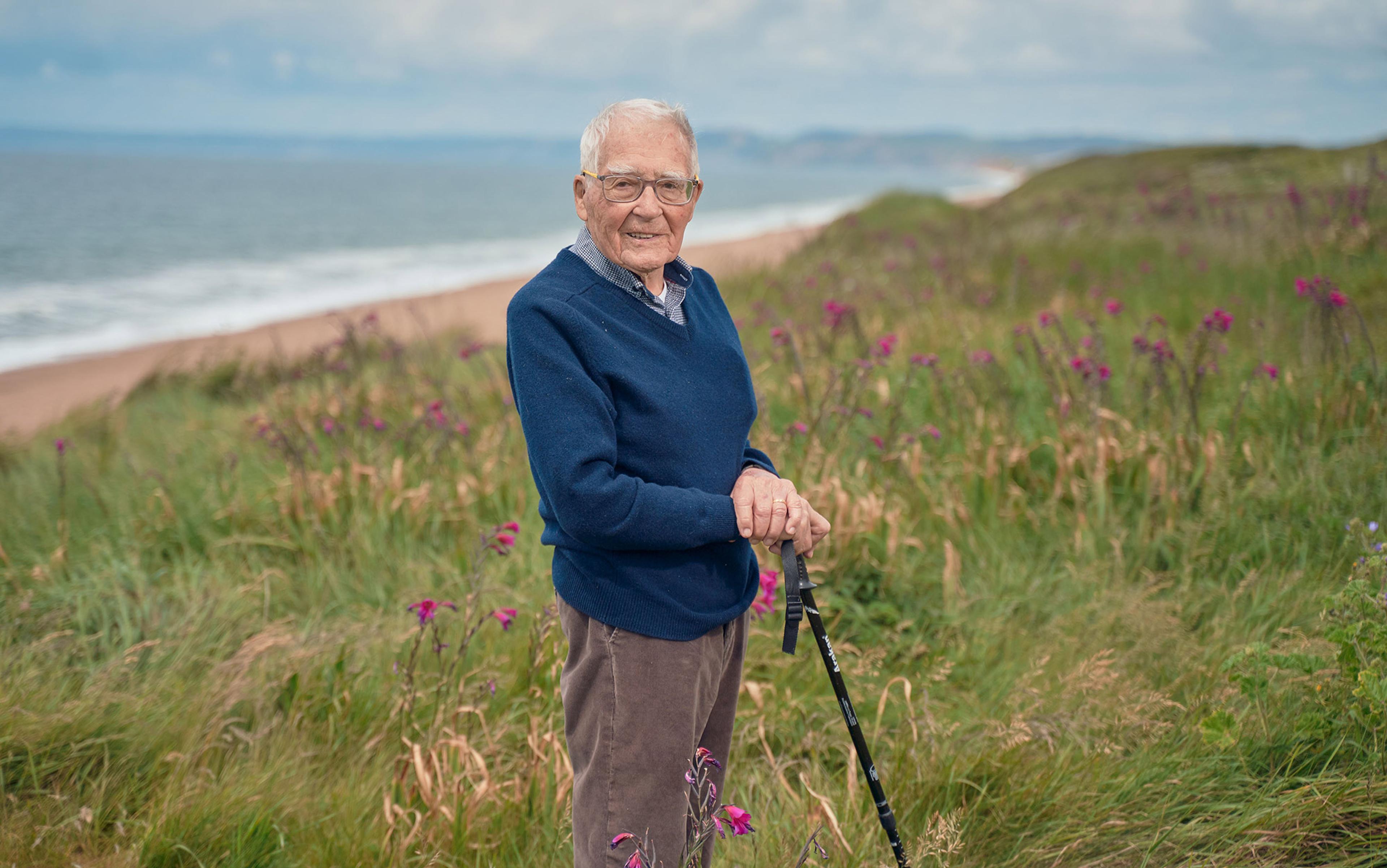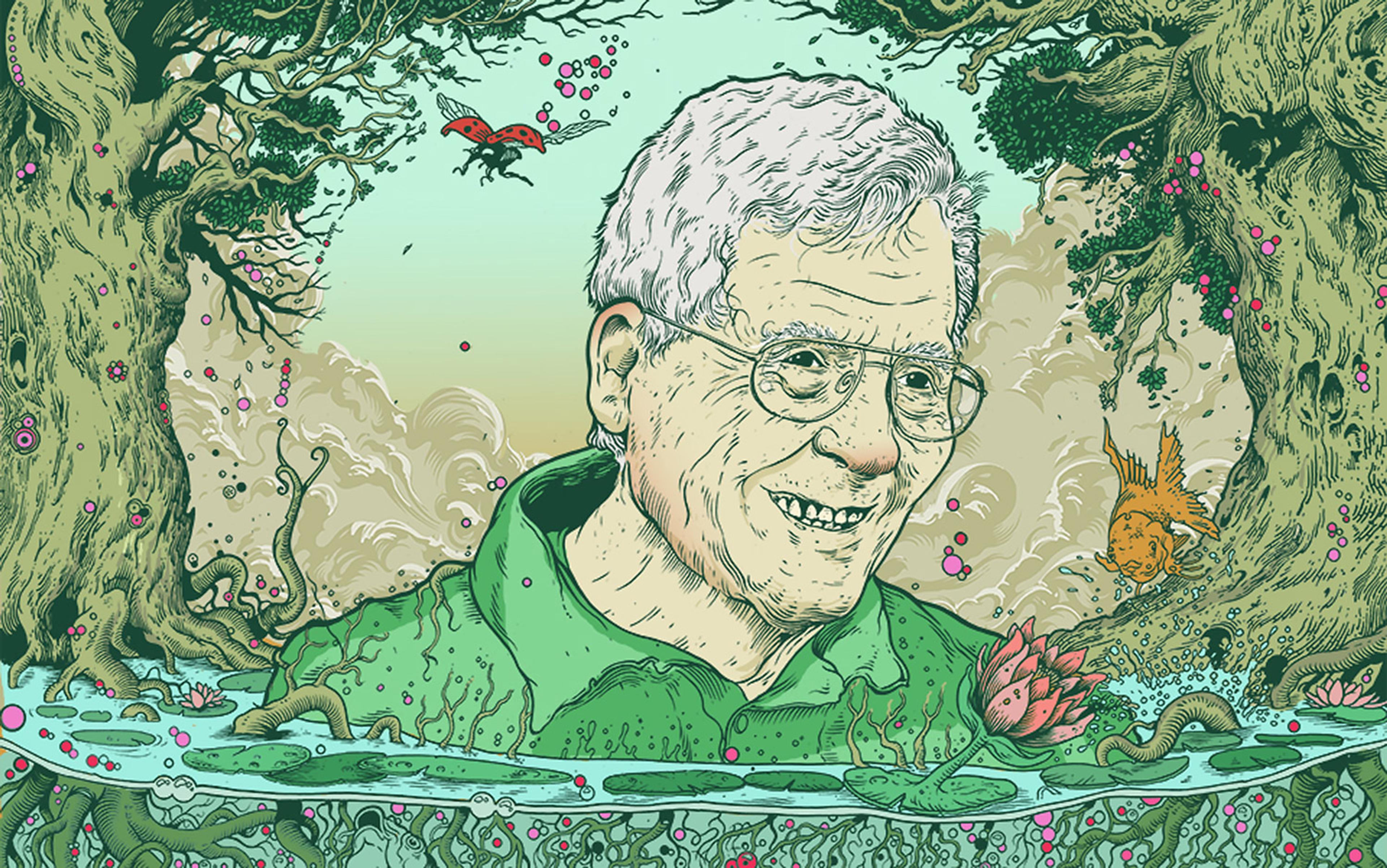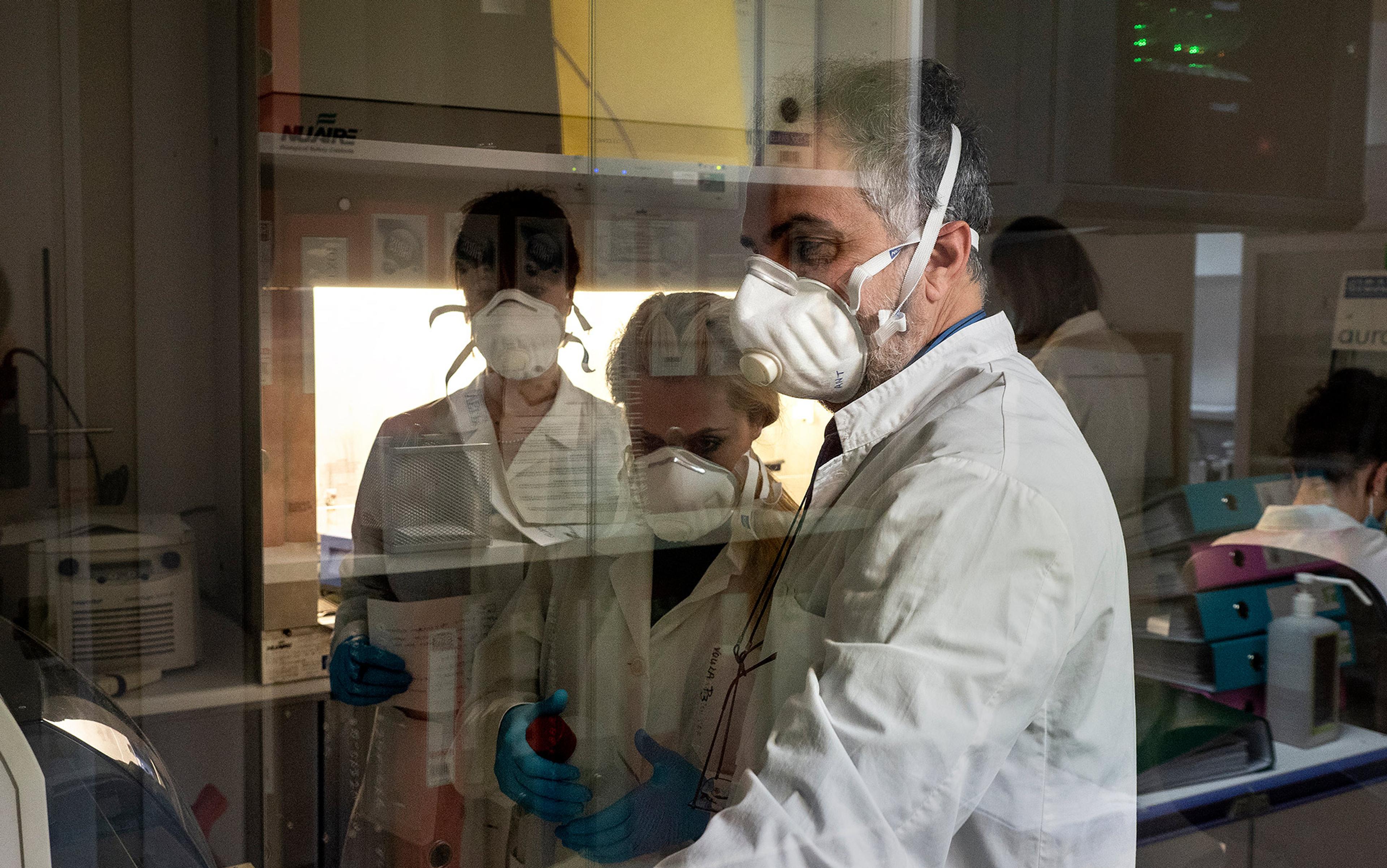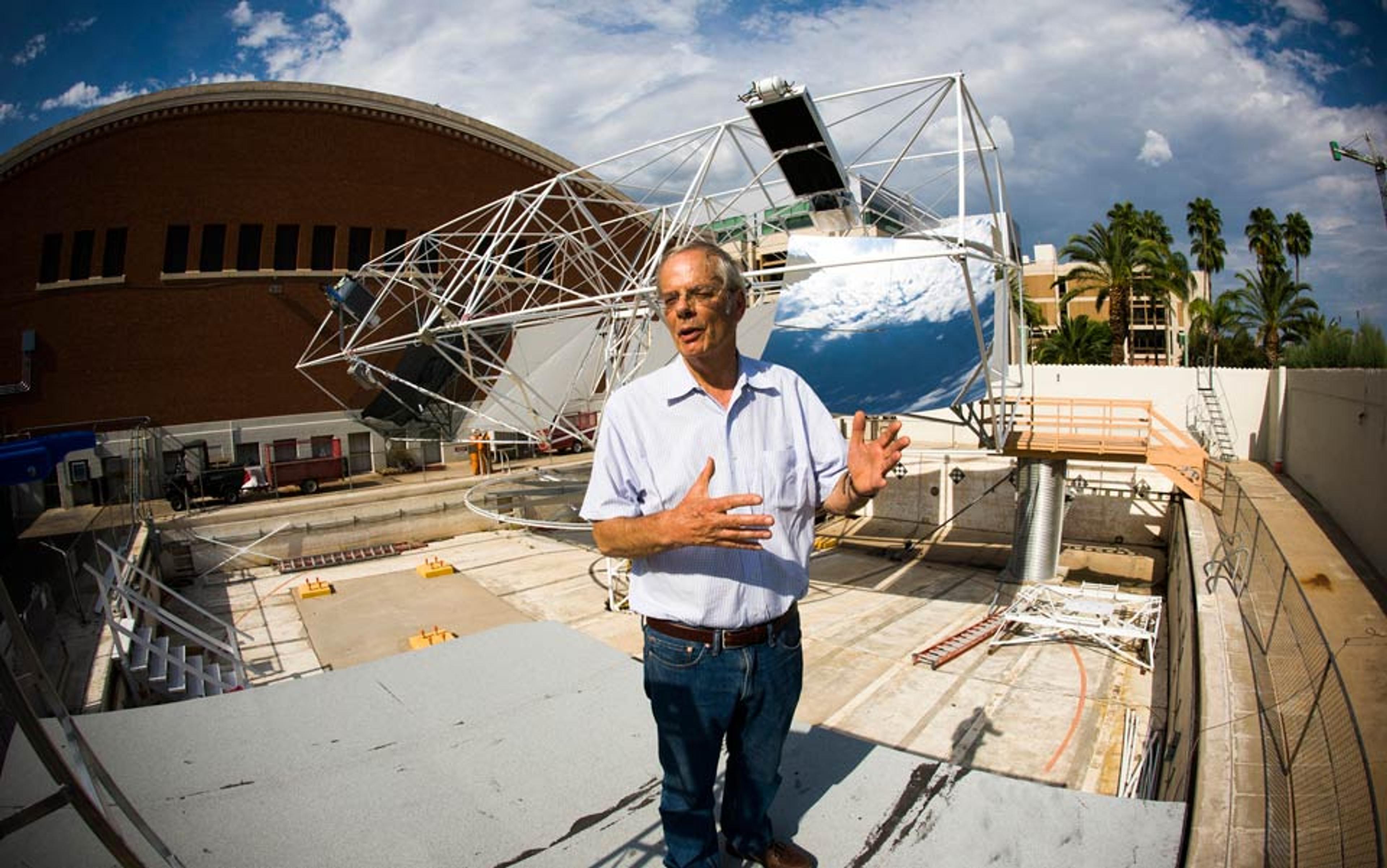As the planet lurches towards a climate emergency and its life support systems falter, the need for visionary thinkers with fresh insights and big ideas has never been more pressing. No wonder, then, that the world mourned the death earlier this year of James (‘Jim’) Lovelock, whose Gaia theory provided a new framework to think about nature, one that changed the way we regard our relationship with Earth.
Lovelock contributed to many fields, such as environmental science, cryobiology and exobiology, from thawing hamsters to building exquisitely sensitive detectors to find life on Mars or to sniff out ozone-destroying chemicals. But when he died on 26 July, the day of his 103rd birthday, the world lost what the Earth scientist Timothy Lenton in Science magazine called ‘a genius and iconoclast of immense intellectual courage’. Lovelock was a true original who was detached from the pressure to conform, one who had found a way to do research outside an institution, and who showed a disregard for disciplinary boundaries.
Driven by his scepticism about conventional wisdom, enabled by his skill as an inventor, and guided by visceral scientific insights, Lovelock made much of his independence. When asked about ‘thinking outside the box’ at a meeting in the University of Exeter to celebrate his centenary, he replied: ‘What box?’
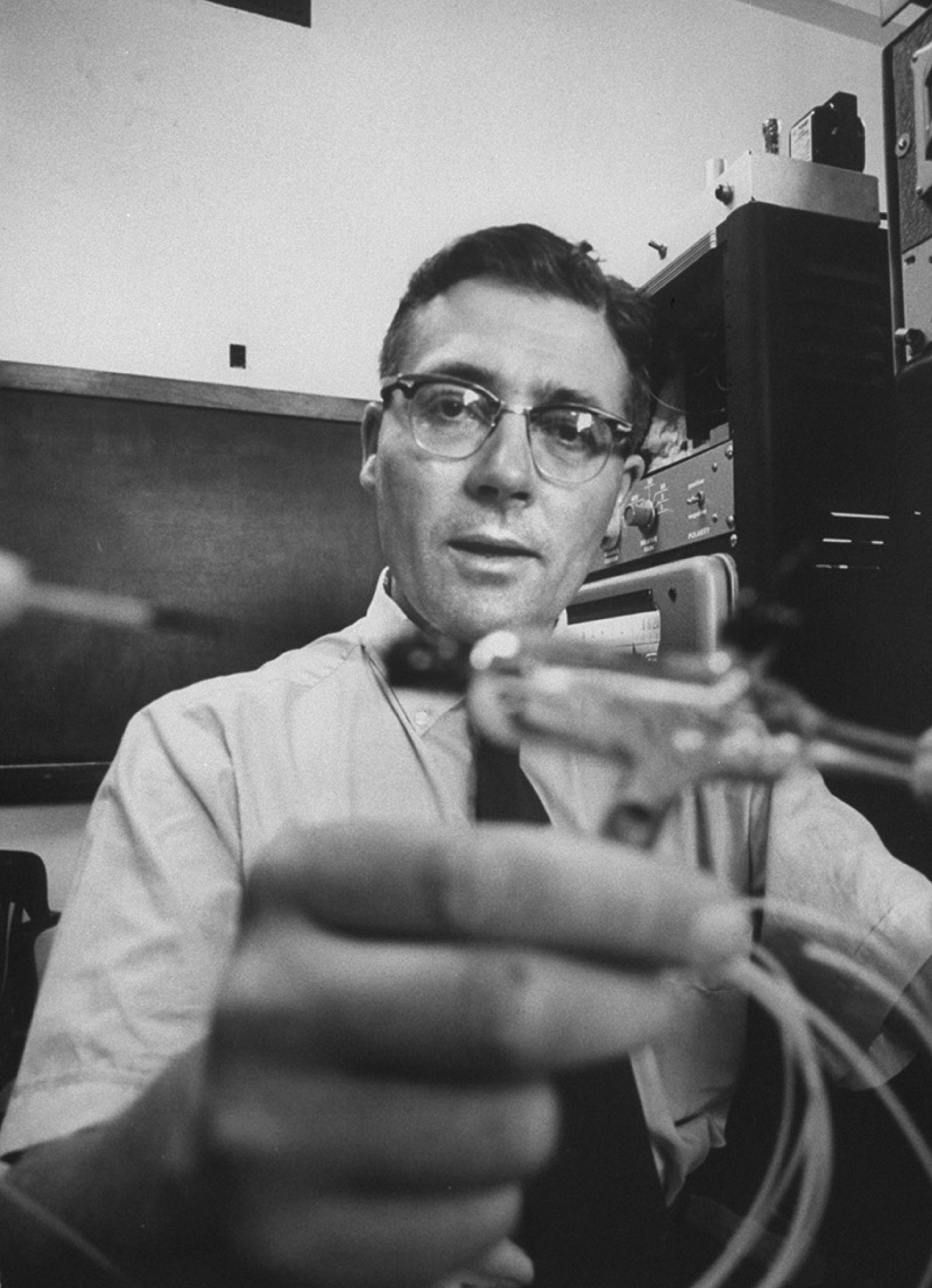
James Lovelock engaged in NASA-funded research at the University of Houston in 1962. Photo by Donald Uhrbrock/Getty
In the literature, you can see how his peers struggled over the decades to pigeonhole Lovelock. In an article he co-authored for New Scientist magazine in February 1975, when Gaia appeared on the cover, he was described as ‘one of the last of the old-style natural philosophers’ who ‘works from his own home’, which at that time was near Salisbury in southern England. Early on, the journal Nature rejected him because, as they told Lovelock: ‘We don’t publish papers from home addresses. They mostly come from cranks.’ To get around this, Lovelock took a visiting professorship at Reading University. Two decades later, his contributions to Nature accepted that he was indeed an ‘independent scientist’. By 2014, the Science Museum in London where I work unveiled an exhibition celebrating his life with the strapline: ‘Scientist, Inventor, Maverick’. Gaia was long established by then.
The torch for Gaia is carried today by many, notably the aforementioned Lenton, director of the Global Systems Institute at the University of Exeter, who told me: ‘His Gaia hypothesis revealed that the thin film of life, air, water, soil and sediments at the planet’s surface is a remarkable, self-regulating system. My scientific hero, mentor and a wonderful friend, Jim was the original Earth system scientist.’
Even by the time of the Science Museum exhibition, however, Lovelock remarked that independent scientists were ‘as rare as ectoplasm’. When he started as a lone scientist-inventor in 1961, the bureaucratic restrictions were easy to overcome but being independent would be 100 times harder to do today, he told me. His kind were going extinct.
That same year, as we discussed A Rough Ride to the Future (2014), one of the many books he wrote to help fund his work, Lovelock bemoaned how research had become a ‘contest of hugely expensive teams in the science equivalent of an Olympic stadium.’ But, he wrote in 2014, a ‘million reasonably intelligent men or women gathered at the ultimate interdisciplinary conference would rarely, if ever, match an Einstein or a Darwin. Much worse, the funding of that million would leave nothing over to sustain a lone genius.’
He was, however, careful to tell one biographer, Jonathan Watts in The Guardian, that ‘I never considered myself even vaguely a genius.’ Even so, with his death, has the world seen the end of the golden age of the independent expert? My colleague at the Science Museum Alex Rose, who curates Lovelock’s archive, remarked that the reality is more complex: ‘Jim carefully cultivated his persona as an independent scientist – but we might ask exactly what “independent” means, or why he chose to describe himself this way.’
Lovelock’s love of science and engineering, along with his autodidact streak, was evident early on. Born in 1919, in Letchworth Garden City, Hertfordshire, his earliest memories included watching the Flying Scotsman steam locomotive thundering past in nearby Hitchin.
He was raised in Brixton, south London, where the public library fired up his fascination with science – not least thanks to science fiction written by the likes of Jules Verne and H G Wells.
At an event with him in 2014, he told me how frequent visits to the Science Museum, starting with one in 1925, made a profound impression. His father had encouraged him to look at the museum’s steam engines, and press buttons, ‘and I did’, he said. ‘It was great – I never looked back.’ The science that preoccupied him during his career came from what he’d gleaned as an ‘SBN’ or ‘small bespectacled nerd’ (his term) in the museum and in libraries, not in school science lessons or homework, which he found tedious.
Lovelock’s inventive flair was also given free rein when, aged four, he got a wooden box from his father, filled with electrical odds and ends, for Christmas. He later invented an airspeed indicator that he could use during train journeys.
‘It’s time for the dissolution of the universities. They are very like the Church was way back in the Middle Ages’
Because his parents were unable to support their son at university, Lovelock became a lab technician in industry, and studied for a BSc at evening classes. ‘I chose employment as a laboratory assistant in the late 1930s to learn the craftsmanship of science,’ he wrote in 2014.
For the next two or so decades, he did medical research as a postgraduate, almost all of it as a tenured staff member of what was the National Institute for Medical Research (NIMR) in north London, rounding off his scientific apprenticeship. Then, from 1961 to 1964, he was employed as a professor in Texas, at Baylor College of Medicine: ‘During that time I fully developed my vocation as a lone practitioner,’ he wrote in A Rough Ride to the Future.
In later life, however, he could be withering about the value of higher education: ‘It’s time for the dissolution of the universities,’ he said in an interview with the Idries Shah Foundation in 2019. ‘They are very like the Church was way back in the Middle Ages. They’ve got too comfortable and cosy, and they’re not really doing their job.’
Even so, Lovelock relied on higher education to succeed. Another British independent scientist is Stephen Wolfram, who stepped out of a successful academic career to develop his Mathematica software, and is trying to recreate the fundamental physics of the cosmos from scratch, using what he calls ‘ruliology’. At first, as Wolfram said in a YouTube Q&A in 2022, ‘I could kind of shoehorn some quite original things’ into the rubric of mainstream physics. Only with this scientific apprenticeship could he become independent from the ‘rhythm of the traditional scientific establishment’.
Preferring to work outside the tramlines of an institution or discipline, Lovelock was also unusual in that he was both a scientist and an inventor. Science and engineering, he wrote, ‘are like a married couple that has never fallen out of love’.
This umbilical cord that connects thinking with making has been apparent for centuries. Rose, my Science Museum colleague, worked on our Science City gallery, which tells the story of how London became a scientific powerhouse in the 17th and 18th centuries, and was struck by how talented instrument makers from the continent – none as famous as the likes of Isaac Newton, Christopher Wren or Robert Hooke – propelled the scientific revolution.
Another driver of scientific creativity was conflict, according to Lovelock. He began his working life in the Second World War, and believed that invention, science and war ‘have always been tightly connected’. In 1943, his boss had given him a few hours to create an instrument to measure heat radiation accurately. More than 70 years later, he would write: ‘I suspect that posing the same need now to a civil service laboratory would provide several months’ work for a team of scientists and technicians.’
Lovelock also lived his life inventively: he had used a prototype microwave to reanimate a chilled hamster, avoiding the burns caused by thawing its heart with a heated spoon, but was delighted to find the technology could also warm his lunch at the NIMR, a pioneering use of microwave cooking in the 1950s.
He supported himself from the early 1960s through consultancies, which would come to include Shell, Hewlett-Packard, Pye Chemicals and the intelligence services. That gave Lovelock free rein to exercise his inventiveness. Working in his home laboratory, he did not have to wear the uniform of a white coat but ‘old clothes that could be discarded if contaminated’.
A sci-fi aficionado, Lovelock leapt at the opportunity to work for NASA in Houston
Critical to remaining independent was his invention of the electron capture detector (ECD) – an extraordinarily sensitive way to spot traces of toxic chemicals that, he claimed, was ‘responsible for kicking off the Green movement’. Its development began in the late 1950s when he was still part of the establishment, in response to a challenge from a colleague at the NIMR.
.jpg?width=3840&quality=75&format=auto)
Lovelock’s electron capture detector, 1960. Photo courtesy Wikimedia
Lovelock refined the instrument on sabbatical in 1959 at Yale University in the US, and his ECD could now identify trace amounts of contaminants in the air. A key moment came when he discovered that carbon tetrachloride blinded the detector, suggesting ‘phenomenal sensitivity’, he recalled. The device was particularly good at picking up compounds containing halogens, such as chlorine, that ‘worry the environmentalists’.
While the patent rights were awarded solely to Yale, losing Lovelock tens of millions in royalties, a retainer from Hewlett-Packard allowed him to pursue his research. Rather than boost his standard of living, he wrote that ‘the bulk of my income went towards the science I did.’ Around that time, his skills were in demand. During the 1960s, the recently formed US space agency NASA began to prepare to explore the solar system, and in March 1961 wrote to Lovelock in recognition of his development of small yet simple and sensitive instruments that were ideal for space missions. A sci-fi aficionado, Lovelock leapt at the opportunity to work in Houston.
After three years, he decided to return to the UK where, in his home laboratory, then in Bowerchalke, Wiltshire, he developed a ‘rough’ weight-saving prototype to analyse the Martian atmosphere. At its heart was a fine palladium silver alloy tube that was heated to around 200°C to separate different chemical components from the atmosphere carried in hydrogen gas, doing away with the need for heavier equipment. One of his most treasured moments came when he demonstrated the device to NASA engineers at the Jet Propulsion Laboratory (JPL) in Pasadena and the ‘rocket scientists … gave a great cheer’ when it worked.
Lovelock also began to consider how to detect life on a planet like Mars. Rather than focus on molecules such as DNA or proteins, which assumed (mistakenly, he thought) that Martian life is like that on Earth, he realised that the atmosphere would be pushed out of equilibrium by the reactive gases produced by living processes, such as methane and oxygen. A corollary of this brainwave was that life would change its environment, as it does on Earth. In his talk at the Science Museum in 2014, Lovelock said: ‘It immediately dawned on me that if life can regulate the atmosphere, it can regulate the climate.’ This marked another insight that would pave the way for Gaia.
In his book Gaia: A New Look at Life on Earth (1979), Lovelock himself described Gaia, his greatest creation, as ‘the hypothesis, the model, in which the Earth’s living matter, air, oceans and land surface form a complex system which can be seen as a single organism, and which has the capacity to keep our planet a fit place for life.’ Earth, then, is in some sense alive, a living system of which we are all a small part.
The name ‘Gaia’, after the Greek earth goddess, was coined early on by William Golding, the author of Lord of the Flies (1954) and Lovelock’s neighbour in Wiltshire. But Lovelock could never quite cut free from the establishment to develop Gaia, not least with his use of the ECD to study the planetary environment.
He had applied for a Natural Environment Research Council grant to travel by ship to Antarctica to use his ECD to search for traces of CFCs, industrial chemicals. The referees refused to believe his claim that the ECD could detect chemicals at concentrations as low as one part per trillion – equivalent to detecting a single drop of ink diluted in a body of water equivalent to 20 Olympic-sized swimming pools – and wrote off his application as ‘bogus’ and ‘frivolous’. But the programme manager, after seeing Lovelock’s equipment, quietly gave him a berth on RRS Shackleton, which set sail in December 1971. Even in the remotest region, Lovelock still detected CFCs – showing for the first time that these chemicals had dispersed across the entire globe, a discovery that would take on huge significance when CFCs were linked to a hole in Earth’s protective stratospheric ozone layer.
Lovelock honed his ideas during the 1970s, partly with the equally inventive and unconventional biologist Lynn Margulis, who had worked with Lovelock at JPL in Pasadena and was the ex-wife of the cosmologist and science populariser Carl Sagan. She, as Lenton likes to say, ‘put microbiological flesh on the chemical bones of the [Gaia] hypothesis’.
‘Of all the main things I’ve done, probably the idea of Gaia is the invention I think the most important’
Like Lovelock, Margulis had also changed our view of life, through her concept of ‘endosymbiosis’, the idea that our complex cells depend on simpler tenants. Nature has mixed and matched single-celled creatures for aeons. One instance of endosymbiosis can be found in plants, which date back to ancient ancestors that became verdant only around 2 billion years ago, when they abducted green creatures that could turn sunbeams into food. Our cells are also powered by mitochondria, descendants of bacteria that once traded chemical energy for a comfortable home. Lovelock and Margulis had crossed paths because of her interest in how oxygen was generated by life and, he recalled, ‘we were scientific soulmates’. Her ideas placed life in a grander context, as did Gaia. And her ideas were also derided, as was Gaia. Not helped by its name, Gaia theory was ridiculed as ‘new-age nonsense’ though those familiar with nonlinear systems could see where Lovelock’s thinking pointed, where negative feedback can stabilise the climate, and positive can cause flips and tipping points.
‘From the early days, the biologists hated it,’ he recalled. ‘They said it was anti-Darwinian and got really quite rude about it. The Earth scientists were almost as bad.’ The journal Nature rejected their joint paper on Gaia. Smiling, Lovelock told me how the biologist Richard Dawkins joked that, for Gaia to work, all species must meet annually on top of Mount Ararat to decide what climate they wanted.
Lovelock loved a challenge. In 1983, he published a simple computer model to demonstrate the gist of Gaia, developed with his student Andrew Watson, then at the Marine Biological Association in Plymouth (Lenton was, in turn, Watson’s student). Lovelock would later remark: ‘You can easily distinguish lone from communal scientists by the authorship of their papers. The true loners write alone or with one, or rarely two, colleagues.’
Their model, called Daisyworld, was the subject of my first interview with Lovelock, in 1991. Their digital parable showed a planet populated with black and white daisies where the lighter flowers thrived in a warmer climate, and the darker ones when it was cooler. Because white daisies reflect more sunlight and black daisies absorb it, the spread of either variety creates feedback that keeps the climate constant. Today, these feedback loops abound in climate models.
Lovelock’s patient, good-humoured and non-dogmatic style paid off. By 1988, the first international scientific conference on Gaia took place, marking its wider acceptance. From the outset, the public loved Gaia, and the idea that they were part of a superorganism. Lovelock himself told me: ‘Of all the main things I’ve done, probably the idea of Gaia is the invention I think the most important in my lifetime.’
At the University of Exeter, Lovelock’s vision has been extended by Lenton, known for his work on tipping points, where a small change can irreversibly alter the global climate, so that rainforest can turn into savanna, savanna can rapidly become desert, or the gulf stream current that warms Britain’s climate can dwindle. After working with the French sociologist Bruno Latour (who died earlier this month), Lenton believes that humans have the potential to ‘upgrade’ the Gaian planetary operating system to create ‘Gaia 2.0’. By this they mean that, as humans become more aware of the global consequences of their actions, deliberate self-regulation becomes possible where we limit our impacts on the planet.
There are what Lenton calls ‘positive tipping points’, where collective action by legions of people – to switch away from meat, adopt electric vehicles or whatever – can curb harmful climate change. Lenton says Gaia is becoming ‘self-aware’ and this could help humanity to achieve global sustainability.
Centuries ago, research was carried out by what some call ‘gentleman scientists’. Like Lovelock, they were not affiliated to a public institution, such as a university or government-run outfit. But, as my colleague Rose explained it to me, that earlier era was different in that there were almost no paid scientific jobs. The only people with both sufficient leisure to do science and the means to buy instruments and books were those with independent wealth like Charles Darwin, who had enjoyed a large inheritance from his father.
The gentleman scientists had thrived from the Renaissance until the late 19th century, including the Victorian era, before large-scale government and corporate funding became available. Like Lovelock, though independent, they were not solitary: Darwin, for example, spent decades at the heart of an extensive correspondence network of ‘pigeon fanciers, dog breeders and farmers, as well as men of science,’ Rose told me.
All science was done this way once upon a time. However, around the turn of the 20th century, once science got big, the role of independent scientists got small. Rose believes that Lovelock was neither a gentleman scientist nor an independent scientist, ‘but a consultant who gets the money to do what he wants from some of the largest corporations of the 20th century.’ He was highly organised about his consultancy, even when unwell (he had a heart bypass operation in 1982), and worked hard to carve out enough time for his own research.
Lovelock was independent in the more restricted sense that he was shielded from the many influences that set and mould the agenda of research: funding increasingly follows a policy agenda, and is shaped by government ministers who are eager, as ever, to yoke science to their short-term political agenda, or that photo opportunity with a high-vis jacket and hardhat. ‘As any artist or novelist would understand – some of us do not produce their best when directed,’ he wrote in his autobiography Homage to Gaia (2000).
He once said the only real purpose of committees was to select the date for their next meeting
Gaia is totemic of complexity science and emergence, where the whole is more than the sum of its parts, where living things interacting with inorganic processes keep the planet in a state where life can persist – despite a brightening sun, volcanic activity or meteorite strikes. But modern academia is crammed with reductionists who lurk in ever more fragmented niches, each with its own customs, language, funding streams and establishments.
Other pressures on researchers come from their university or department: it goes without saying that these institutions are more likely to hire a like-minded individual who understands their agenda. While Lovelock never accepted a university-tenured position, he did hold visiting professorships and even admitted that he could have endured being within a university, ‘provided that social, tribal and bureaucratic influences were minimal’.
Once shackled to a university, a researcher is lumbered with teaching obligations, administrative duties, regulations, the neverending obligation to apply for grants, and bureaucracy. As Lovelock wrote in 2014, ‘a Faraday or a Darwin would be buried in paperwork and obliged to spend their time solving problems concerning health and safety, and political correctness, today’s equivalent of the theocratic oppression of Galileo.’ Up to a point: Faraday worked at the Royal Institution in London, where he had responsibilities to lecture, not least to deliver the popular Christmas lectures, which he initiated in 1825.
Lovelock did not have to deal with office politics but he did have to submit his ideas to peer review. Committees would assemble to weigh up papers or grant submissions and, of course, Lovelock was withering about groupthink: he once told me that the only real purpose of committees was to select the date for their next meeting. Even worse, their consensus thinking was prejudiced against outsiders. This mattered because, without peer-reviewed papers to judge the merit of an applicant, funding agencies would not offer loners financial support.
Being part of the establishment also gives scientists access to expensive facilities that can be shared by many. Lovelock, however, was suspicious of data that spewed forth from a commercially developed black box: ‘such apparatus (even when said to be the latest) was probably 10 years out of date,’ he wrote in 2014. ‘I knew as an experienced inventor of scientific instruments that it takes many years to develop the working model of an idea into practical, saleable hardware. I could invent new equipment that was truly at the leading edge, so why did I need to buy what was already outdated?’ Having said that, Rose recalled how, on her first visit to Lovelock’s lab, it was ‘ram-packed with Hewlett-Packard equipment’.
Though independent, Lovelock was still connected with the scientific establishment, and in many ways. Wolfram is among a handful of independent scientists, like the British physicist Julian Barbour, and he told his YouTube audience that to achieve independence means doing your homework, building on earlier research, remaining in touch with relevant experts, being entrepreneurial, and constantly explaining what you are doing and why other people should care: ‘It is not trivial to make that work.’
There were other facets of Lovelock’s brand of independence. A service was held in Weymouth Crematorium in Dorset at the end of August for 100 or so close friends and family to say their goodbyes. As the funeral celebrant Howard Evans ‘returned him to Gaia’, he told us that, though agnostic, Lovelock had a respect for the religious and hankered after the transcendental. And, although seen by many as a seer of the environmental movement, Lovelock felt many Greens represented another kind of establishment that hindered rational thinking, particularly when it came to nuclear power (‘Too many Greens are not just ignorant of science; they hate science,’ he wrote in Homage to Gaia). He once told me that, when he lived in Devon, he had so much land that he would have happily buried the nuclear waste output of a nuclear power plant there ‘for free home heating’.
When Rose entered his laboratory in a converted barn, she remembered how the Geiger counter she was advised to bring along ‘went insane’: Lovelock was blithely unconcerned by radioactivity. One vivid example emerged at his funeral. His daughters referred to him as a ‘connoisseur of nature’ but one who so hated wasps (even though he quite liked hornets) that he once put a dab of radioactive tracer on a wasp to help find its nest.
The microwave mounted on the lab’s wall was used by Lovelock to store his explosives, presumably for his research for the military and security services (he once described himself as a ‘Mini Q’, in reference to James Bond’s research scientist). Lenton recalled Lovelock opening an old ice-cream tub and asking him to identify what was inside – an orange, putty-like substance. Plasticine? No, Semtex! His watchmaker’s lathe, which Lovelock had used to make the ECD and other instruments, took pride of place in his laboratory.
When in 2012 Rose went through Lovelock’s archive – more than 80 boxes of material – his independence shone out of his school reports, which revealed a reluctant pupil with a passion for nature, hand-decorated Christmas cards (featuring wormlike creatures he dubbed ‘Luvles’), along with paintings and Bond-style stories.
For Rose, the ‘independent’ tag was a canny way for Lovelock to defend himself against criticism, a defiant signal that he was not to be easily pigeonholed. When Lovelock talked about being an independent scientist, ‘what he meant is independent-thinking’, she told me. This became apparent when he discussed Gaia, his greatest legacy, in a film for the Science Museum, and declared somewhat portentously:
In 50 years’ time, which is far beyond anything I would care to predict, if there are people sitting around like we’re sitting now, I think they’ll have gone a few stages further in … accepting that the planet’s alive, and using that in their ordinary conversation. But I don’t think it’ll be very big scientifically. Think of Darwin and natural selection. Fifty years after he introduced it, it was hardly mentioned at all.
Perhaps that is what Lovelock really meant when he said he was independent: he was simply waiting for the rest of us to catch up.
